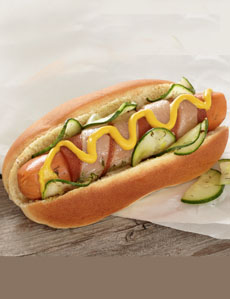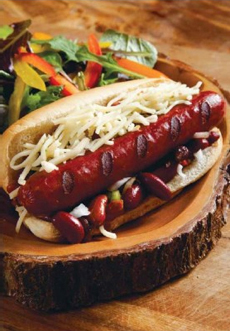FOOD HOLIDAY: National Hot Dog Day
|
|
June 23rd is National Hot Dog Day, and we’ve got a new hot dog recipe: the Cubano Dog. It’s a riff on the Cubano (Cuban) Sandwich, a variation of ham and cheese made with ham, roasted pork, Swiss cheese, sliced dill pickles and mustard on lightly buttered Cuban (or Portuguese) roll.
Here, the hot dog and bun replace the pork and bread. Check out the different types of sandwiches. The differences between hot dogs and sausages is below. The recipe is from Lightlife, a Nibble Top Pick Of The Week that specializes in delicious meatless alternatives. But any dog works: beef, bison, chicken, turkey or veggie. RECIPE: CUBANO DOG You can use store-bought pickles instead of making your own (it’s quick and easy!).
|
|
|
For The Pickles |
||
|
Preparation 1. MAKE the pickles. In a heat-proof bowl, toss together cucumbers and dill. Set aside. 2. HEAT the vinegar, sugar, mustard seed, salt and garlic in a small saucepan over medium-high heat for 3 to 5 minutes, until the liquid begins to simmer and the sugar dissolves. Pour the liquid over the cucumbers and toss to coat evenly. Cover and place in the refrigerator. The pickles can be prepared up to 2 days in advance. 3. TOAST the rolls. If using Portuguese rolls, first slice them in half. You can toast them under the broiler at the same time as you broil the hot dogs. and the bread is toasted. 4. TURN the oven to broil. First cook the hot dogs in a medium saucepan, covered with water. Bring to a boil; turn off the heat. Let the hot dogs sit in the water for 2 minutes. 4. ROLL 1 slice of ham around each dog. Place on a baking sheet (along with the hot dog rolls) and broil for 2 minutes. Remove the baking sheet from from broiler and add 4 slices of cheese to each dog. Broil for an additional 1 to 2 minutes or until the cheese is melted. 5. REMOVE from the oven. Top each dog with 1/4 cup of drained pickles. Serve with mustard. |
|
|
|
HOT DOG VERSUS SAUSAGE: THE DIFFERENCE The hot dog—also called a frankfurter and a wiener—is a type of sausage: ground meat stuffed into a casing*. The American hot dog differs from other sausages based on ingredients, origin and size. The original name for the hot dog, frankfurter, comes from a small town called Neu-Isenburg, located on the road from Frankfurt to Darmstadt. Every town in Germany has its own sausage recipe: blend of meat, spicing, etc. The frankfurter, a slender sausage like today’s frank, was made from pork. The name “wiener” comes from Vienna, Austria; the German name for Vienna is Wien. The wiener is similar to the frankfurter in recipe, but slightly shorter in size. Sausages appear in print as far back as Homer’s Odyssey, about 850 B.C.E. The earliest possible reference to “hot dog” occurs in the late 17th century. The written record is incomplete, but a sausage maker from Coberg, Germany named Johann Georghehner may have invented a sausage he called “little dachshunds,” or “little dogs.” Recipes for the predecessor of the American hot dog came to U.S. with immigrant butchers of several nationalities. While as uncertain as the Georgehner story, it is believed that in 1871, Charles Feltman, a butcher from Germany, opened up the first Coney Island hot dog stand selling 3,684 “dachshund sausages” in a milk roll during his first year in business. [Source: HotDog.org] Since sauerkraut and mustard were typical accompaniments to German sausages, they found their place atop the hot dog, later to be joined by many other toppings; for starters, bacon, cheese, chili, ketchup, onions, pickles/pickle relish, salsa and slaw. While we don’t know the different recipes of the first American hot dogs, it is beef rather than pork that has prevailed—possibly, because Nathan’s, today the world’s biggest hot dog brand, was a kosher recipe. In 1916 Nathan Handwerker, a Polish immigrant, started a nickel hot dog stand on Coney Island with a $300 loan from two friends—Eddie Cantor and Jimmy Durante, both local boys. But it was his wife’s secret spice recipe that is attributed to the success over other vendors.
|
||




